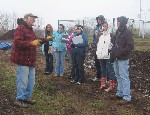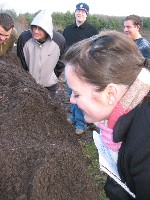Posted on Friday, December 5, 2008
These were tough kids! Well, they weren't really kids, nor actually tough in the sense of street talk. These were Westminster College students who, amid blustery winds and frigid temps, trekked to the Field Station (some walked out, some drove), stood outside to see and sample the realities of composting, and even asked good questions despite their shivers.
Students in four lab sections of Biology 101, Concepts in Biology, were led here the first week of December by Professors Shahroukh Mistry, Joseph Balczon, and Philip Fawley. They came to the site where Westminster processes campus food waste for composting. The demonstration was a revelation to most of them who eat in the dining hall or the Campus Center and never before wondered what happened to their leftover food or the kitchen waste that went into preparing their food. Now they know! Most of them showed their "toughness" by putting on gloves and assisting with the sorting of campus food waste.
Here is what had to be removed from the food waste bags that were opened for sorting before the "good stuff" could be composted: plastic knives/forks/spoons, plastic plates, soda cans and bottles, latex gloves, plastic bags and, yes, even a few metal spoons and forks. Here is what could be composted: peelings and rinds, cut-off veggie parts, apple cores, overripe bananas, outdated bread and vegetables, partially eaten sandwiches and salads, uneaten pasta, coffee grounds, napkins, tea bags, paper cups and plates.
Students learned that more than two tons of these are generated each month on campus and brought to the Field Station. Sorted food waste is mixed with stable waste (a.k.a., manure) in a pile called a "green soak" - high in nitrogen and "soaking" as one would in a bathtub - where it sits and anaerobic respiration generates lots of heat (and chemicals that smell). Then the stuff of "table and stable" is moved into long rows to which are added the carbon-rich compostables like autumn leaves, community yard waste, chipped wood, and shredded paper. Microorganisms metabolize these organics (called feedstocks) by breaking down complex molecules into simpler molecules to produce the end product called compost. They saw the stirring take place (that blends the feedstocks and adds oxygen) and the screening of the final product (that makes it useable as a soil supplement). At this point, the compost smells like . . . dirt. Good dirt.
Composting activity goes on at the Field Station 12 months of the year, albeit a bit slower in winter. The heat produced by the microorganisms is sufficient to keep the rows above freezing for all but the very coldest months. Students took the temperatures of the "green soak" and found a balmy 110-121° F when the outside air temperature was 28°. They saw and sampled (by smelling) the finished product and knew in their heart of hearts that this is a good thing for the College and the environment. Westminster must continue to "talk the talk and walk the walk" of sustainable living.
In my days and years of classroom teaching I often taught Westminster students enrolled in Bio 101. These are students who will shape the attitudes of the next generation (most of those enrolled are planning to teach elementary school); these are people who will become writers, artists, accountants, and policy makers for the future; and these are the folks who are tough on days like the first week of December. On this generation of students rests a tremendous responsibility.
Clarence Harms, Director
Field Station
(724) 946-8520
E-mail: harmsc@westminster.edu



